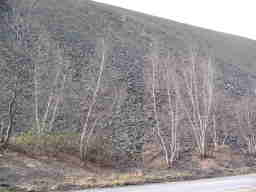 |
Clean Coal Technology Fact or Fiction, Fallacy or Forward thinking? |
 |
Many politicians are touting clean coal technology as a viable fuel source. There is a rising chorus of people from science, alternative energy businesses and industry who dispute these assertions. In the United States, we burn coal to make electricity. The emissions are waste from burning coal that have already had many negative consequences including: several kinds of local air pollution, air pollution drift, forest destruction by acid rain, mercury pollution of waters and the problematic disposal of toxic fly ash.
Investigate the concept of clean coal. Listen to the University of Michigan's The Environment Reports:
Coal: Dirty Past, Hazy Future - Part 1 | Part 2 | Part 3 | Part 4 | Part 5
What is clean coal technology? at How Stuff Works | Learn about clean coal technology
Exposing the Myth of Clean Coal Power Time
Toxic coal ash piling up in ponds in 32 states AP | Coal Ash Spill raises questions - New York Times
Energy Information Administration - Basic Coal Information | Energy Basics 101 | Renewable and Alternative Fuels Basics 101
![]() Discover - You use electricity every day.
Discover - You use electricity every day.
Where is your electricity generated?
How is it generated?
What energy alternatives are locally available?
What energy generation alternatives are locally feasible?
![]() Explore the concept of clean coal. Research the issue/idea.
Explore the concept of clean coal. Research the issue/idea.
Identify the positives and negatives of clean coal technology.
Is the clean coal energy concept viable?
Should taxpayers invest billions in researching and developing it?
Who will be the winners and losers in pursuing clean coal technology?
![]() T. Boone Pickens has offered a national energy plan.
T. Boone Pickens has offered a national energy plan.
Compare and contrast his plan with the clean coal technology concept using a Semantic Feature Analysis or matrix. (Matrices @ Math Dude)
Need Help?
Comparison and Contrast Guide @ ReadWriteThink - Tip: Click the right pointing arrow after reading each page.Which plan do you prefer? Support your choice.
![]() Alternative thinking:
Alternative thinking:
Read: Garrett Yazzie, 13, invents solar heater for his family's home and Junk Yard Genius
What actions can you take to address our energy challenges?
Identify one change your school could make to reduce energy use.
Why would the businesses that sell energy, downplay the individual household
generation of solar or wind power?
Extensions:
Show what you know
Make an Energy Digital Video - Compare/contrast the clean coal proposal with another energy source option.
Careers for the future:
Identify 3 jobs related to energy sources or production.
Which do you believe has the greatest potential for providing a long term, living wage?
What kind of training is needed for that job/career?
What are the positives and negatives of that career?
Energy Forecasts to 2030 - CSPAN free online video | Mapping Renewable Energy, Rooftop by Rooftop - Time, 12/22/08
Energy Activities and Information Resources:
Problem Based Learning Projects / Internet Hunts / Nature / Computers / Pennsylvania Projects / Puzzles & Projects / Site map / Home
developed by Cynthia J. O'Hora. Posted 4/2009
Released to public domain in honor of Garrett Yazzie for his creative actions to solve his family's energy problem.
![]() Save a tree use a digital answer format - Highlight the text. Copy it. Paste it in a word processing document. Save the document in your folder. Answer on the word processing document in a contrasting color (not yellow) or font (avoid:
Save a tree use a digital answer format - Highlight the text. Copy it. Paste it in a word processing document. Save the document in your folder. Answer on the word processing document in a contrasting color (not yellow) or font (avoid: ![]() , Symbol,
, Symbol, ![]()
![]() or other ornate artistic fonts). Save frequently as you work. Submit your work via a class electronic drop box or email attachment. Bad things happen - always save a copy of your work on your computer.
or other ornate artistic fonts). Save frequently as you work. Submit your work via a class electronic drop box or email attachment. Bad things happen - always save a copy of your work on your computer.
Proof your responses. It is funny how speling errors and typeos sneak in to the bets work. ![]()
Aligned with Pennsylvania Academic Standards for Environment and Ecology, Science and Technology, Careers, Civics and Government, Reading Writing, Speaking. 4.2. Renewable and Nonrenewable Resources A. Explain that renewable and nonrenewable resources supply energy and materials. • Identify alternative sources of energy. • Identify and compare fuels used in industrial and agricultural societies. • Compare and contrast the cycles of various natural resources. 10. A. Analyze the use of renewable and nonrenewable resources. • Explain the effects on the environment and sustainability through the use of nonrenewable resources. • Evaluate the advantages and disadvantages of reusing our natural resources. 12. A. Analyze factors affecting the availability of renewable and nonrenewable resources. • Evaluate the use of natural resources and offer approaches for using them while diminishing waste.